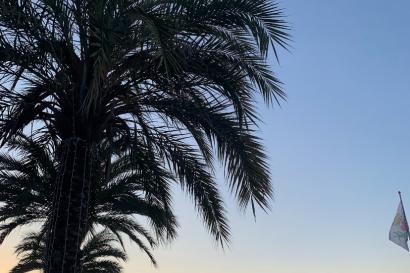The first field study that our class took in Siena was to a gelateria called Kopakabana (Via Rossi 52). Since the six of us were addicted to Grom (a delicious international chain that is conveniently located only 4 minutes away), I was excited to try something different. In fact, Kopakabana seems to be a classic gelateria with both gelati and sorbeti, which I was happy to find out about.
In the small shop, the owner led us to the back where they made gelato. There wasn’t much to this back area, since it is only two even smaller rooms with products and four machines that make gelato. It was actually quite hard to take a picture of the room because it was so small.
Since he did not speak any English, our professor translated for us what he was saying. In one of the machines, he mixed the gelato base (the dairy products) and heated them to kill off any bacteria that may have been present. Thereafter, he poured this mix into another machine that would cool and churn the base. At this point, flavors in the form of liquid are added to the base; however, he did not add any flavors to ours so the gelato that he made for us was “stracciatella,” a cream flavor. When the gelato was finished churning, he took out a rectangular metal dish and slowly guided the gelato with a spatula into the dish creating a fluffy almost cloud-like design. Afterwards, he drizzled chocolate cause on top of the white gelato to add some flavor. As the chocolate sat atop the gelato, it hardened in random chunks. He then sat the gelato down and allowed us to try it. Although I am lactose intolerant, I tried 5 large bites of this outstandingly fresh gelato. It had an absolutely amazing creamy flavor that was heavy but still light enough to continue to want to eat it. The hardened chocolate only added to the flavor, giving it a different texture and a balance of flavor.
The owner then showed us the liquid form of many of the flavors that he makes including pistachio, nutella, Coca-Cola, and rose. As soon as he opened each bucket, the smell was so strong that it was obvious which flavor it was. Each smelled amazing.
Then, we were given the chance to order our own choice of gelato. I decided on pompelmo (grapefruit) and fragola (strawberry), which ended up being a delicious combo.
So far, I’ve been back only once but I plan on coming more! The people who worked there were very sweet and welcoming, similar to many other people we’ve met here in Siena!
Typical “markets”
For our second field study in Siena, we went to two typical “markets” to see some of Tuscany’s specialty foods. The first was the Consorzio Agrario Siena, which is a market that sells everything from wine to meats to cheeses to pizza to olive oil from the Tuscan region. We saw many products that we had been talking about in class. One such food was finocchiona, which is a Tuscan dried salami with fennel made from Cinta pigs (black pigs with a white belt on their shoulders and forelegs). Another was Pici pasta, which is a Tuscan specialty as well, similar to spaghetti in that it is long and circular but it is thicker and therefore has a doughier taste. (In fact, we’ve been eating a lot of this pasta both cooking it at home and ordering it at restaurants because it is so good!) We now have been back to the Consorzio for pizza, and is has been so fresh and delicious!
The second specialty shop that we visited was a very typical place where Italians come for meat, cheese, and lunch called Il Capperino. The lunch products ranged from prepared rice dishes and pastas to customized sandwiches. Our professor explained to us many of the products in the store including the nicely displayed packets of pasta sauce seasoning. However, what has stuck with me thus far are the delicious panninis that we got that day. I’ve even come back to this amazing place four times since to have their sandwiches. Eat time I have gotten prosciutto, pecorino fresco, and sundried tomatoes. This simple yet decadent pannino has continued to satisfy me because it has a perfect combination of all flavors. Checchino pane is always what I crave when I come here because it is so delicious: it is salty on the outside, crispy, and is thin enough to soak up the olive oil from the sundried tomatoes. This type of bread I believe is more commonly called something else outside of Siena, but Checchino is what the locals have named it. Then the prosciutto on the pannino adds another salty taste that has never been overpowering. The percorino’s creaminess then balances out the saltiness to make a perfect pannino. A coke always goes well with this combo too.
The second time that we came back to this place, the owner was unbelievably nice. It was the day before the Palio, so naturally he was in a great mood since the Onda (his contrada) was racing. As we ate our sandwiches there chatting at the bar, other costumers came in to eat and chat with him. As a friendly gesture, he poured white wine as they ate. He was kind enough to do the same for us and talk with us a little in an Italian-English combo.
Everytime I want a pannino now, this is the place I want to go to especially after finding myself in a tourist trap the other day (11 euros for a pannino, I don’t think so!).
Vino
Italian wine is so well-known that this class would not be possible without a a wine tasting, particularly since the wine of Tuscany is so wonderful. Now, I’m not going to pretend that I know everything about wine after this visit because that is nearly impossible after such a short time. However, I do think that I’m starting to at least get a hang of what is considered good wine here in Italy.
Our class went to the Enoteca in the Siena Fortress, only a few minute walk away from the center. Although this fortress is quite old, it has only in the 20th century been used to collect all varieties of Italian wine. In fact, it was the first place in Italy to do so with the attempt to showcase all the Italian wine has to offer.
In the cool atmosphere under the fortress, the tour guide showed us the various wines that they have in their museum. Each section is organized by region, which makes sense because similar regions produce similar wines due to the types of grape that are used and various aspects within the climate such as soil composition and proximity of the sea.
Then, we went to taste some of the wines from Tuscany on a beautiful deck. Although the place is a little bit of a tourist trap as our professor tried to explain, it was rather pleasant. Our tour guide taught us how to taste wine, since none of us had previously done so. The first thing to do is to check the color of the wine against your hand or even better against a grey sky. The second step is to swirl the wine in your glass. This is something that I never understood and now have begun to comprehend better now. When you swirl wine in a wine glass, a sort of water mark is left on the glass. If droplets take a long time to drip down from this mark, then the wine is of a high percentage and is therefore a better quality wine. If droplets fall down quickly, then the wine is not as strong and regarded less good. Thirdly, smell the wine. Fourthly, take a small sip of wine to re-fresh your palate and then take a larger sip of wine to swish around in your mouth as if you’re “french kissing,” as the tour guide told us. Lastly, enjoy the wine with other similarly paired meats and cheeses. For example, a young wine can be eaten with a young cheese. However, it is important that the flavors go well together instead of overpowering another flavor. Although lots of this was very helpful, we now have a running joke in our group that we can smell a number of crazy things from wine such as children playing in the dirt, grass growing, and cattle grazing since the tour guide seemed to have exaggerate a bit when he named some of the smells from the wine.
Nonetheless, it was quite an experience since we were able to taste three wines, three different meats, and one pecorino cheese. The first wine was a Vernaccia di San Gimingiano, a white wine from a nearby town known for its white wine. The second wine was a Chianti Colli Senesi; Chianti is also a region that is known for its wine in Tuscany, but for its red wine. However, this is not the highly coveted Chianti Classico, the Chianti was still good. The strongest of the three wines and the wine that was served last was a Tosco Forte, which I unfortunately know less about than the other two wines.
After this class, we have all been trying a few of the wine tasting techniques as well as knowing a little bit more about which wines we should be drinking, especially in Tuscany. However, we are definitely still learning!

Gabrielle Lubin
<p><span style="color: rgb(29, 29, 29); font-family: Arial, Verdana, sans-serif; font-size: 12px; line-height: normal; background-color: rgb(237, 237, 237);">Ciao!! I’m a rising senior from Bowdoin College in Maine studying Psychology and Education. Even though I go to school in a small town, I’m from the big city of Chicago, but I am ecstatic to explore yet another beautiful small town, Siena! Starting in high school and continuing onto college, I have blogged about the various delicious desserts that I have been lucky enough to enjoy. This has been my way of expressing my sweet tooth for all to see and try. It has also allowed me the privilege and opportunity to try things that I never would have otherwise, such as a wide range of cuisines in various “local” areas that I may never have ventured to. For me, trying a new dessert—or food in general—is not only about how it tastes but also who you are with, what the atmosphere is like, and how you feel about the food. I aim to convey these experiences to my readers through photographs and short descriptions. I am anxious and open to try all that Italy offers to add onto my delectable list!</span></p>
























